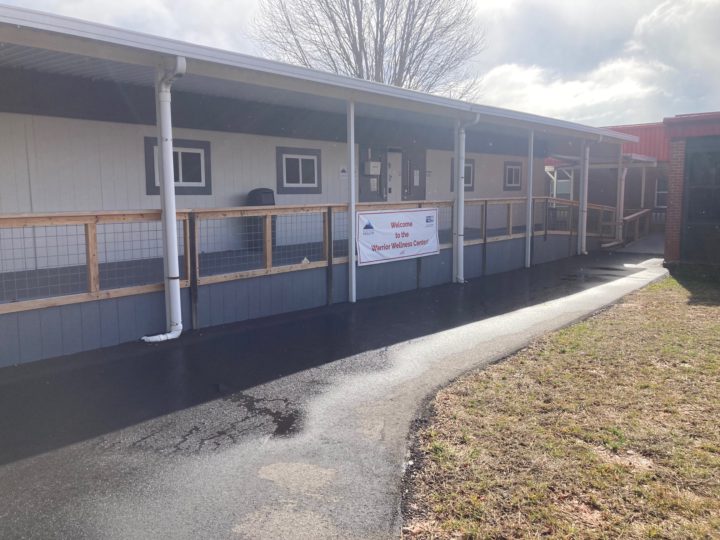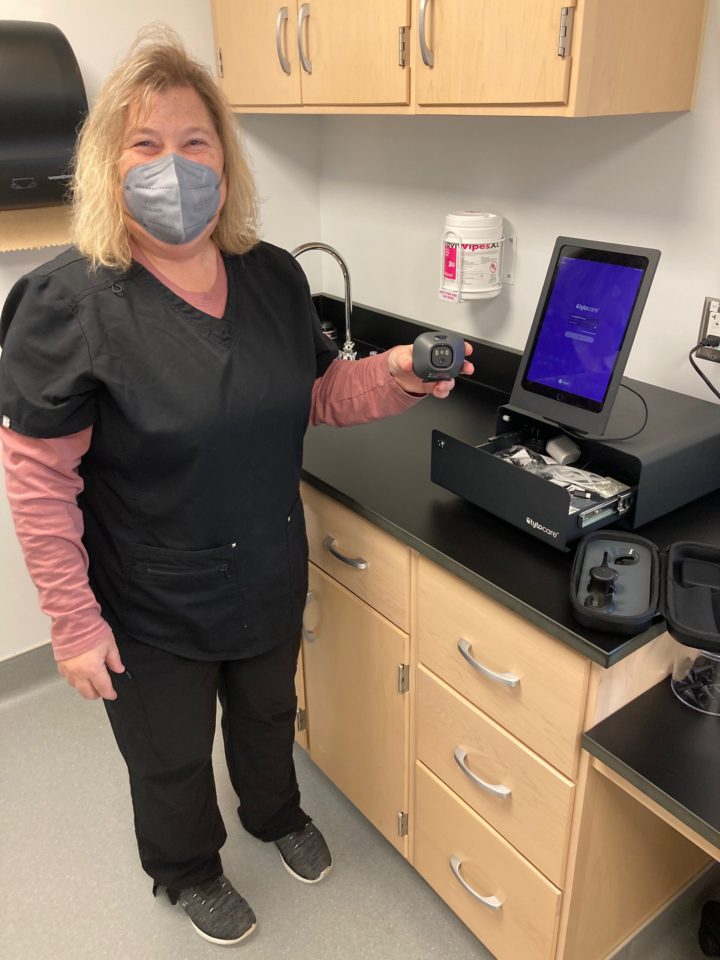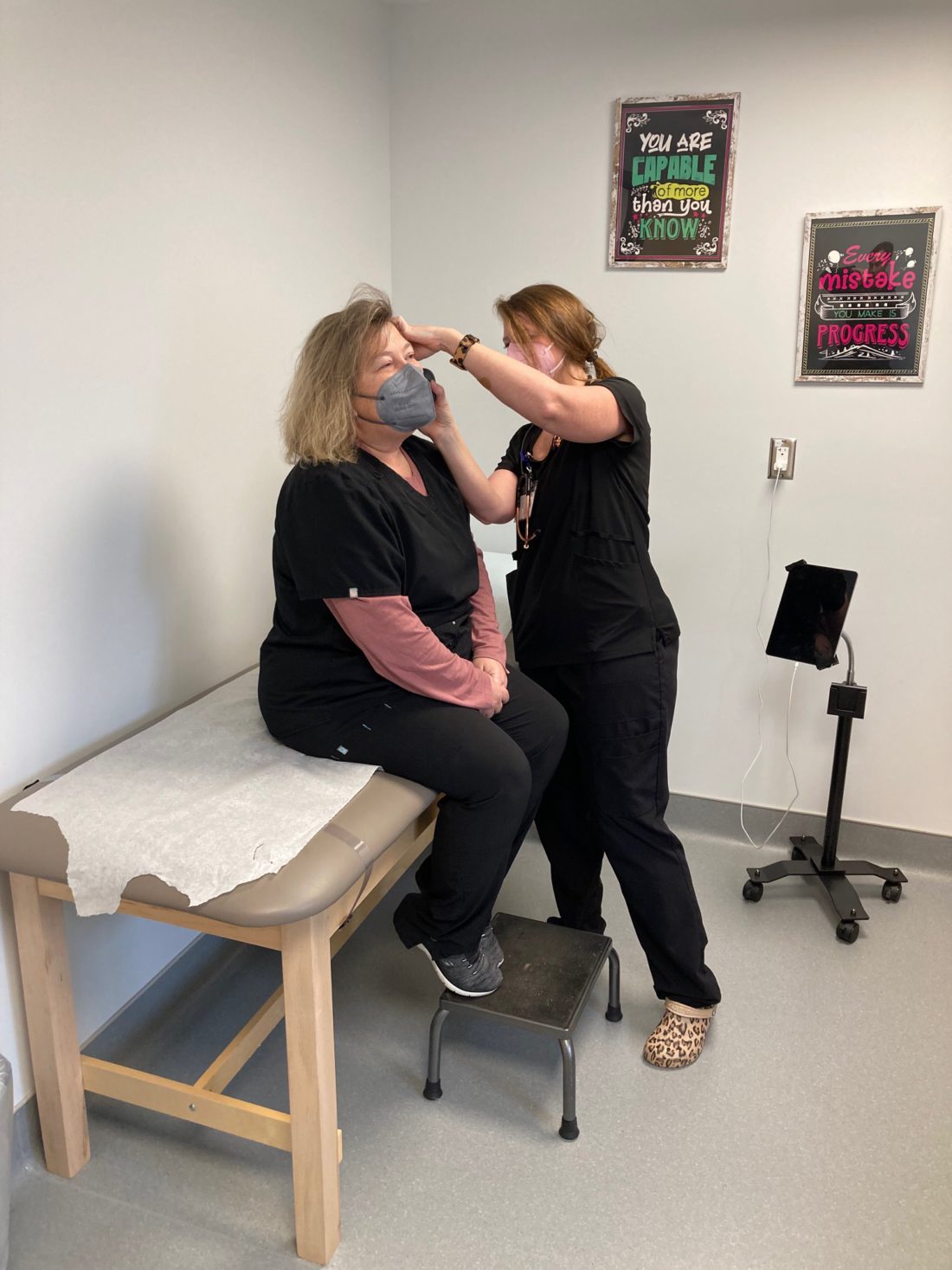There’s much more to the unassuming modular unit at the back entrance to Clyde A. Erwin Middle School than meets the eye.
Inside, a registered nurse, nurse practitioner and mental health counselor provide close to doctor’s office-level care for students, faculty and families of Buncombe County Schools’ Erwin district, right on the middle school campus.
The Warrior Wellness Center, which opened in fall 2022, is one of 34 school-based health centers, or SBHCs, operated by Blue Ridge Health around Western North Carolina and the first of its kind in BCS. Asheville City Schools’ Asheville Middle School opened a similar center on its campus earlier in 2022.
The SBHCs provide everything from well-child checkups, physicals and immunizations to care for acute issues, prescriptions and counseling services.
It’s about bringing health and wellness to the students in the school beyond what a typical school nurse can provide, says Tammy Greenwell, chief operating officer of Blue Ridge Health, based in Hendersonville.
The clinic is complete with a waiting room, a small processing area, two exam rooms, a lab where vaccines are stored and blood can be drawn, an office where clients can speak with a licensed counselor, a nurse’s office and a break room.
The SBHCs accept public and private health insurance, and are available to serve as a student’s primary care doctor, if necessary, Greenwell says.
“We just try to make sure we’re getting them access to those services and getting them connected to care, whatever that care may be that they need,” she adds.
Startup funds for the centers at Erwin and Asheville Middle schools were provided in part by United Way of Asheville and Buncombe County as part of its community schools program. Asheville High School also has a school-based health center funded and operated by Appalachian Mountain Community Health Center, says Deborah Calhoun, director of community partnerships at United Way.
The clinic at Asheville Middle treated 372 students, and Erwin’s saw 361 in its center between October 2022 and Sept. 30, 2023, Calhoun says.

Travis Collins, Erwin’s principal, says the health center’s impact goes beyond day-to-day student health.
“This is another thing that we can do to help that child understand that when you come here, we’re going to take care of you,” he says. “We’ll take care of your physical needs, your mental health needs, your academic needs, your social emotional needs. This is a brand-new platform that helps us build those positive relationships with our students and their families.”
Keeping kids in classrooms
One of the most impactful benefits of having the health centers right on campus is their ability to keep students from missing school for routine checkups or minor illnesses, Collins says.
If a child isn’t feeling well, instead of potentially sending them home, they can head across campus to the Warrior Wellness Center and get treated without leaving school, as long as their parents or guardians have given the clinic permission to treat their child.
“If they find out that it’s not, you know, strep throat or something like that, [the nurse] can contact the family, get permission to give that child Motrin, ibuprofen, you know, some easy fix, and then that kid is back in class. That makes a huge difference,” Collins says.
In fact, of the 733 students served at Asheville and Erwin middle schools, only 2.5% did not return to class and had to be sent home for a specific illness or condition. A quarter of students who visited the SBHCs improved their overall school attendance, Calhoun says.
“School attendance is one of your highest predictors of not only student achievement outcomes but graduation rates,” Collins adds.
Even if a student is too sick to send back to the classroom, having a clinic on campus can save parents the time of having to find an appointment with a primary care doctor to diagnose and treat what is ailing their child, Collins says.
“That can be tricky. If you’re a parent, you know that you’re not always going to get that appointment. Same-day care is not that accessible for a lot of our families.”
Jo Landreth, principal at Asheville Middle, says the benefit of reduced absences applies to students who aren’t sick and just need required immunizations.
In North Carolina, a slew of vaccinations are required by the end of the first month of school for students in kindergarten and seventh grade, creating a scramble to schedule appointments for some families. Landreth says she is fortunate that in reminder letters to parents, she can offer the on-site clinic as an option to those who may not have the time to schedule an off-site appointment.
There are also annual checkups, sports physicals and minor illnesses that can cause students to miss time at school.
“I think the greatest benefit is that kids can get the care they need without having to miss a day of school,” Landreth says. “Particularly for families who don’t have their own transportation. And if the kid doesn’t go on the bus to school, then they’re not going to come late either. So before there was a health center, you would have students who might miss a whole day because they needed a quick appointment somewhere.”
Plus, the clinic is available for use by teachers and their immediate families, which can save them time, limiting staff absences as well, Landreth adds.
Working with the school nurse
These days, not every school has a full-time nurse. At both Erwin and Asheville, the school nurse, who is employed by Mountain Area Health Education Center, splits time between other district schools, meaning they are not always available.
Landreth says Asheville’s school nurse manages more long-term health concerns like helping the students with diabetes stay on their treatment plans. She also manages health assessments that parents fill out with their child at the beginning of the school year, prepares teachers and administrators for students’ health needs before field trips and responds to basic concerns that may come up like a dehydration-induced headache, she adds.

If a child isn’t feeling well and the nurse is out of office, however, that can result in more missed instructional time in schools without a SBHC, Collins notes.
But at Erwin and Asheville, there is always a registered nurse a short walk away. At least two days a week, a nurse practitioner is also on-site.
The nurses at the SBHC have a good working relationship with each school nurse, says Christy Willis, the registered nurse stationed at the Warrior Wellness Center.
They call each other if needed, all in the service of getting children what they need.
In one example of collaboration, Greenwell said a child was seen by the school nurse, who determined the student had a fever. The nurse sent the student to the SBHC, where a swab was taken, showing the student had strep throat. Since parents had given consent, the nurse prescribed antibiotics, and the student waited to be picked up by a parent, she said.
“I do have peace of mind that that child that does not feel well, we can pack and walk down the hallway, right to a nurse practitioner and a nurse, [and] they can take care of that child with the parent’s permission,” Collins says. “And then many times we can put them right back in class, and they feel better.”
Even when the nurse practitioner is not at the clinic, the service is available via a videoconferencing system. In that instance, the on-site registered nurse can use equipment with an embedded video camera to look down the patient’s throat or ear while a nurse practitioner can watch from afar and direct the nurse on-site. They can also virtually listen to a patient’s breathing. Willis is “the hands” of the off-site provider, who can then offer the student a diagnosis and prescription if necessary, she says.
Community schools
The SBHCs are one piece of a wider effort spearheaded by United Way to ensure “all Asheville City and Buncombe County students graduate from high school ready and fully prepared to pursue their goals and dreams” by 2035, according to its website.

This United for Youth Network, which includes many area partner organizations, currently partners with seven “community schools” in Asheville and Buncombe County. These schools have a liaison to help bridge public schools to families and community organizations to help ensure all students “learn, grow and thrive in a healthy, vibrant and connected community,” according to the website.
“The schools can’t do it all,” Calhoun says. “We have a role as a community to support students and families and schools, to make them as warm and as welcome as possible so students will ultimately graduate high school in order to pursue their dreams.”
School-based health is “a major, important piece” of that effort, she adds.
Both Erwin and Asheville middle schools are community schools in that program, which, Calhoun says, is adding two schools soon.
Collins says being a part of the community school program and the addition of the Warrior Wellness Center have been instrumental in helping build trust among his school’s stakeholders, especially families.
“It just creates another way in which we have a positive relationship with our families. And it’s another way in which we can show them that we care.”
Future expansion
At Erwin, the modular is accessed via Service Road, along the backside of the school, and visitors don’t have to walk through the school to get to the clinic. That makes it easier for those not on campus to access the clinic, which encourages participation around the Erwin district, Greenwell says.
All students and teachers at any school in the Erwin district are welcome at the Warrior Wellness Center, as well as their families, Collins says.
Eventually, there are plans to add services adjacent to the clinic at Erwin, like a food pantry and a clothing closet, creating a “one-stop shop” for that community, Calhoun says.
At Asheville Middle, the clinic was incorporated into the existing campus buildings, Greenwell says. That has its own advantages of feeling even more accessible for students already at the school, but because potentially sick people not already at school would then bring their germs through the front office when seeking care at the clinic, it’s not ideal, she notes.
Another SBHC is on its way, at Enka Middle School, and will be modeled after the Erwin location, Greenwell says.
Collins says Enka should be excited, and he can’t endorse the SBHCs enough.
“It’s amazing to see the number of ways that it has positively impacted not just my school, but the larger Erwin community,” he says. “It is truly a game changer in the way in which we can take care of our students and our staff and our community.”



Before you comment
The comments section is here to provide a platform for civil dialogue on the issues we face together as a local community. Xpress is committed to offering this platform for all voices, but when the tone of the discussion gets nasty or strays off topic, we believe many people choose not to participate. Xpress editors are determined to moderate comments to ensure a constructive interchange is maintained. All comments judged not to be in keeping with the spirit of civil discourse will be removed and repeat violators will be banned. See here for our terms of service. Thank you for being part of this effort to promote respectful discussion.